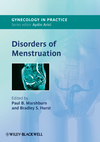Learn how to interpret menstrual cycle events as vital signs for women.
Irregularities in the pattern and amount of vaginal bleeding of uterine origin are often signs of pathology or an
aberration in the function of the hypothalamic, pituitary, and ovarian system. The type of menstrual disorder when
coupled to the women's age can give important signals as to the likely problem.
Disorders of Menstruation follows the reproductive lifetime of women, from prepubertal abnormalities through the years
of potential child bearing to menopause and beyond. The authors provide a conceptual framework to understand the
mechanisms responsible for abnormal menstrual bleeding or early pregnancy failure.
This clinically focused book is written for any practicing clinician who provides healthcare for girls and women.
Disorders of Menstruation highlights accurate diagnostic algorithms that lead to evidence-based therapy or minimally
invasive surgery using approaches that are practical, efficient, and cost-effective.
A new addition to the Gynecology in Practice series.
Series Foreword.
Dedications.
Contributors.
1 Overview: Disorders of Menstruation (Paul B. Marshburn and Bradley S. Hurst0.
2 Prepubertal Genital Bleeding (Kristin M. Rager, Preeti P. Matkins, and Tara M. Vick).
3 Irregular Vaginal Bleeding and Amenorrhea During the Pubertal Years (Bradley S. Hurst).
4 Menstrual Disorders During the Reproductive Years (Michelle L. Matthews).
5 Abnormal Menstrual Bleeding in Hyperandrogenic Ovulatory Dysfunction (Rebecca S. Usadi).
6 Abnormal Uterine Bleeding due to Anatomic Causes: Diagnosis (Bradley S. Hurst).
7 Abnormal Uterine Bleeding due to Anatomic Causes: Treatment (Bradley S. Hurst).
8 Infrequent Menstrual Bleeding and Amenorrhea During the Reproductive Years (Paul B. Miller).
9 Menstrual Cycle-related Clinical Disorders (Paul B. Marshburn).
10 Irregular Bleeding During the Menopause Transition (Isiah D. Harris and William D. Schlaff).
11 Postmenopausal Bleeding (Karen D. Bradshaw and David Tait).
Index.
Colour plate section.


